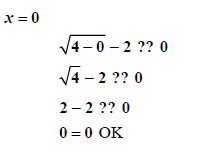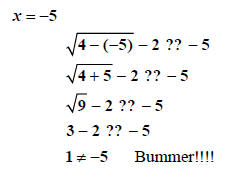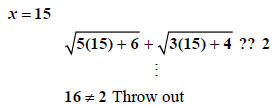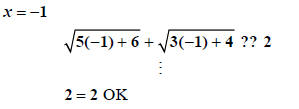Radicals
Rationalizing the Denominator
(1) The process of eliminating radicals from denominators
is called rationalizing the denominator. There are many techniques for doing
this depending on the nature of the denominator. We’ll study only two of them.
The first of these methods applies when the denominator is just a radical, and
it uses the insight gained by having worked with the (S) rule above.
Examples:

Since this is a square root, we need objects in the
radicand that are raised to a
power that is a multiple of 2. We have  is
the closest. We can get 512
is
the closest. We can get 512
that by multiplying numerator and denominator by
 I like to think of this as
I like to think of this as
“multiply by 1 in disguise with radicals”—the old Beatles song!


First use (M2).
4 is a multiple of 2, so
 is not a worry. The next multiple of 2
is not a worry. The next multiple of 2
past 5 is 6, so we multiply by 1 in disguise with
radicals:  While
While
we’re at it, we’ll simplify the numerator.

- - - - - - - - - - - - - - - - - - - - - - - - - - - - -
- - - - - - - - - - - - - - - - - - - - -

This is getting boring. The current powers are 1, 2, and
7. So
weneed 2, 2, and 8 which we can get by using 


Oh, the same radicand, but a new index. Now we want powers
that are multiples of 3. In this case we want 3, 3, and 9. Thus we use



Now the index is 4, so we need the powers 4, 4, and 8.

As we see from these last three examples, what we multiply
the numerator and denominator by depends both on the radicand and the index.
(2) Before we can introduce the second technique, we need
to do some radical arithmetic. The pairs of objects like
 and
and  are
called conjugate pairs. If we apply the special product
are
called conjugate pairs. If we apply the special product
 to these, we get:
to these, we get:

Notice that the radicals vanish in this process. This
observation is used to handle fractions whose denominators are one of these
types of objects. Some examples follow. NOTE: The above ONLY applies for
conjugates involving SQUARE ROOTS – it is not true for cube roots, etc.
 Use
Use
 and multiply by 1 in disguise with radicals.
and multiply by 1 in disguise with radicals.



Radical Equations
(1) A radical equation is any equation containing a
radical with the variable we want to solve for as part of a radicand. At this
level, we will only be interested in square roots – although once you understand
the method for square roots, you should be able to extend its basic idea to
other indices, but I won’t ask you to do that here.
(2) Solving radical equations (square root ones) is fairly
straight forward and the process sounds like the bar tender on the old Love
Boat: ISSC.
Isolate a radical
Square both sides of the equation
Solve the resulting equation
Check your solutions
Example 1:
 |
Isolate a radical. |
 |
Square both sides. |
 |
Note: Square both SIDES, not square all terms!!!! |
 |
Solve the resulting equation. |
| |
Quadratic -> Make equation to 0 |
 |
Factor. |
 |
Zero Product Rule. |
 |
|
But we’re not done just yet! The C in ISSC says Check your
solutions. Check them, that is, IN THE ORIGINAL EQUATION
 Watch very carefully what happens in the
following checking process. We substitute each “answer” into the ORIGINAL
EQUATION and ask if we do indeed have equality.
Watch very carefully what happens in the
following checking process. We substitute each “answer” into the ORIGINAL
EQUATION and ask if we do indeed have equality.


So  does NOT check, and
hence it must be tossed out. The only solution is
does NOT check, and
hence it must be tossed out. The only solution is

What happened here is that  are, indeed,
solutions to
are, indeed,
solutions to  the “squared” equation, but
only
the “squared” equation, but
only  is a solution to the original equation.
The quantity
is a solution to the original equation.
The quantity  is called an extraneous root: a
solution to the square of an equation which is NOT a solution to the original
equation. This can often happen and hence, along with fractional equations, the
technique for solving radical equations requires checking. Unlike the simple
checking for zero denominators that was required for fractional equations, the
checking here must be complete – substitute into the ORIGINAL EQUATION and
verify whether or not the two sides reduce to the same value. In general,
anything could happen in this checking process: you might have to throw one or
more solutions away (as above), throw them all away (solution set is then
is called an extraneous root: a
solution to the square of an equation which is NOT a solution to the original
equation. This can often happen and hence, along with fractional equations, the
technique for solving radical equations requires checking. Unlike the simple
checking for zero denominators that was required for fractional equations, the
checking here must be complete – substitute into the ORIGINAL EQUATION and
verify whether or not the two sides reduce to the same value. In general,
anything could happen in this checking process: you might have to throw one or
more solutions away (as above), throw them all away (solution set is then
 ), or you may get to keep them all.
), or you may get to keep them all.
Example 2:
 |
Isolate a radical, say the first one. |
 |
Square both sides. |
 |
|
 |
Solve the resulting equation. But this is a
radical equation -> ISSC. So Isolate a radical. |
 |
|
 |
Divide through by to simplify. |
 |
Square both sides. |
 |
|
 |
Note the  up
front. up
front.
Solve the resulting equation. |
 |
Quadratic -> make equation to 0. |
 |
Factor. |
 |
Zero Product Rule |
 |
Check. |


Thus the solution is  .
.